Notes: Bury Bolton Street station was on the East Lancashire Railway’s (ELR) Clifton Junction to Accrington line which had opened in two stages between 1846 and 1848. At first the idea was for a line between Clifton Junction and Rawtenstall via Bury which was discussed at a meeting on 24th September 1843, the outcome being the creation of the Manchester, Bury & Rossendale Railway (MB&RR). This company was formally incorporated on 4th July 1844. While construction was under way another company, the Blackburn, Bury, Accrington & Colne Extension Railway (BBACER), proposed to build a line between Stubbins, which lay to the north of Ramsbottom, and Accrington. The aims of the two companies were so aligned that on 21st July 1845 the companies merged as the East Lancashire Railway.
 Bury Bolton Street, the principal station on the line, opened for public services on 28th September 1846. It was originally named Bury, and its main access was from Bolton Street, close to the centre of Bury. The station was not actually completed until 23rd August 1847. Located below street level in a stone wall-lined cutting, a sloping driveway led down to platform level, east of the line. At the Bolton Street end were wrought iron gates bearing the crest of the ELR, with ornamental pillars. There were three platform faces: two were on an island platform on the west side of the station. On the other (southbound) platform, on the east side, was a three-storey Italianate building with a 60-yard frontage and 6-yard depth that contained the usual station facilities but was also the head office of the ELR. It was brick-built with stone quoins and a hipped roof. As at its minor stations the ELR favoured round-headed window and door openings. On the ground floor, facing the platform, there were seventeen of them, with more windows of that style on the first floor, and segmental arches above the windows on the upper storey. An overall train shed, 91 yards in length, was provided, its roof attached to the main building and supported by pillars on the northbound platform. Bury Bolton Street, the principal station on the line, opened for public services on 28th September 1846. It was originally named Bury, and its main access was from Bolton Street, close to the centre of Bury. The station was not actually completed until 23rd August 1847. Located below street level in a stone wall-lined cutting, a sloping driveway led down to platform level, east of the line. At the Bolton Street end were wrought iron gates bearing the crest of the ELR, with ornamental pillars. There were three platform faces: two were on an island platform on the west side of the station. On the other (southbound) platform, on the east side, was a three-storey Italianate building with a 60-yard frontage and 6-yard depth that contained the usual station facilities but was also the head office of the ELR. It was brick-built with stone quoins and a hipped roof. As at its minor stations the ELR favoured round-headed window and door openings. On the ground floor, facing the platform, there were seventeen of them, with more windows of that style on the first floor, and segmental arches above the windows on the upper storey. An overall train shed, 91 yards in length, was provided, its roof attached to the main building and supported by pillars on the northbound platform.
At the time of opening five passenger trains ran on weekdays in each direction between Manchester and Rawtenstall; there were four trains on Sundays.
On 17th August 1848 the line from Stubbins Junction to Accrington was completed. From this date Bury was also served on weekdays by seven northbound trains to Colne and six to Manchester that had originated from Colne. Four services ran to Colne on Sundays and three to Manchester from Colne.
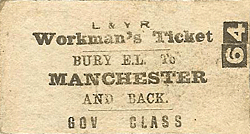 On 1st May 1848 another line opened through Bury: built by the Lancashire & Yorkshire Railway (LYR) it ran from west to east through the town, passing beneath the ELR line immediately south of Bury station. The LYR opened their own station named Bury Market Place (later renamed Bury Knowsley Street) a short distance south-east of Bury station. On 20th November 1848 a connection - ‘Bury East Fork’ - from the south end of Bury station to the west end of Bury Knowsley Street station was built to link the lines, allowing through passenger and goods services between the two companies’ lines. On 1st May 1848 another line opened through Bury: built by the Lancashire & Yorkshire Railway (LYR) it ran from west to east through the town, passing beneath the ELR line immediately south of Bury station. The LYR opened their own station named Bury Market Place (later renamed Bury Knowsley Street) a short distance south-east of Bury station. On 20th November 1848 a connection - ‘Bury East Fork’ - from the south end of Bury station to the west end of Bury Knowsley Street station was built to link the lines, allowing through passenger and goods services between the two companies’ lines.
 On 13th May 1859 the LYR absorbed the ELR. They saw the route between Clifton Junction and Accrington as a useful alternative to their Manchester and Leeds line (which was by this date at capacity) for Trans-Pennine services. They ran numerous express passenger and goods services via Bury, including many of its excursions via the former ELR line. On 13th May 1859 the LYR absorbed the ELR. They saw the route between Clifton Junction and Accrington as a useful alternative to their Manchester and Leeds line (which was by this date at capacity) for Trans-Pennine services. They ran numerous express passenger and goods services via Bury, including many of its excursions via the former ELR line.
In February 1866 the LYR station was renamed Bury Bolton Street.
On 1st September 1879 the LYR opened a line from Manchester to Radcliffe via Prestwich. This provided an additional route to Manchester from Bury through rapidly developing residential areas. Trains on the Manchester and Bacup route were diverted via Prestwich; Manchester and Colne services continued to follow the original route via Clifton Junction.
In the early 1880s the LYR rebuilt Bury Bolton Street to handle the increasing traffic. £12,000 was spent on the project and works were completed in 1883, including raising the platform height and extending them to 250 yards. A bay platform was also created at the south end of the eastern side platform. The trainshed was removed, and new waiting rooms were constructed on the island platform. Both platforms were provided with lengthy canopies supported by iron columns. On Bolton Street a new entrance building was provided, facing the street and located across the line. It was set back a little so that passengers could be dropped off by carriages without obstructing the street. This single-storey building boasted an awning and a clock turret with three clock faces: writing about High Victorian station architecture, Biddle (1973) makes special mention of this feature. ‘Perhaps the most fantastic clock turret of all was the pointed wooden French affair that perched so incongruously on top of the frontage awning (of all places) at Bury Bolton Street’! A covered walkway stretched from the entrance building to a covered footbridge which gave access to the platforms.
Platform 1 was the bay on the east side of the station for train terminating from the south. Platform 2 was bi-directional as were the island platforms 3 and 4.
On 11th November 1882 a line opened to passengers from half-a-mile to the north of Bury Bolton Street to Holcombe Brook. By 1883 a Steam Railmotor was operating a shuttle service every 40 minutes on weekdays. Even on Sundays there were 18 trains.
 In the early 1900s the LYR was facing increasing competition from new electric tramways, notably on its busy Prestwich line. The company considered electrification as a means of challenging tramway competition. The LYR were approached by the Dick Kerr & Co who were early pioneers of electric railways. They suggested to the LYR that they could electrify one of their lines to demonstrate the electrification technology to potential customers: Dick Kerr specifically had in mind a contract to electrify a line in Brazil. The Holcombe Brook branch was selected and electrified using 3500v dc overhead wires, and on 29th July 1913 electric services were introduced between Bury Bolton Street and Holcombe Brook. In the early 1900s the LYR was facing increasing competition from new electric tramways, notably on its busy Prestwich line. The company considered electrification as a means of challenging tramway competition. The LYR were approached by the Dick Kerr & Co who were early pioneers of electric railways. They suggested to the LYR that they could electrify one of their lines to demonstrate the electrification technology to potential customers: Dick Kerr specifically had in mind a contract to electrify a line in Brazil. The Holcombe Brook branch was selected and electrified using 3500v dc overhead wires, and on 29th July 1913 electric services were introduced between Bury Bolton Street and Holcombe Brook.
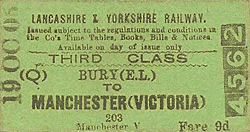 The trial was a success, and the LYR pressed ahead with electrification between Bury Bolton Street and Manchester Victoria, via Prestwich. Interestingly the LYR chose the side-contact live rail system at 1200v dc rather than overhead wires used on the Holcombe Brook line. A frequent service of electric trains began on the Prestwich Route on 17th April 1916. It proved very popular, passenger journeys increasing from 1,884,776 in 1907 to 2,518,638 by the end of 1916. Bacup line trains were diverted via Bury Knowsley Street and Heywood as soon as the electric services began. This added a considerable mileage to their route but it was assumed that most passengers from Bacup line stations to Manchester would change onto the electric services at Bury Bolton Street. The trial was a success, and the LYR pressed ahead with electrification between Bury Bolton Street and Manchester Victoria, via Prestwich. Interestingly the LYR chose the side-contact live rail system at 1200v dc rather than overhead wires used on the Holcombe Brook line. A frequent service of electric trains began on the Prestwich Route on 17th April 1916. It proved very popular, passenger journeys increasing from 1,884,776 in 1907 to 2,518,638 by the end of 1916. Bacup line trains were diverted via Bury Knowsley Street and Heywood as soon as the electric services began. This added a considerable mileage to their route but it was assumed that most passengers from Bacup line stations to Manchester would change onto the electric services at Bury Bolton Street.
In 1917 conversion of the Holcombe Brook branch to the 1200v DC side contact live rail system began and was completed by 29th March 1918, which made it compatible with the Prestwich route; however trains did not operate between Manchester and Holcombe Brook, passengers to or from the branch continuing to change trains at Bury.
On 1st January 1922 the LYR was absorbed into the London and North Western Railway (LNWR). Before signs and logos could be changed the LNWR became part of the London Midland and Scottish Railway, on 1st January 1923.
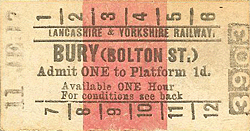 By 1932 passengers using Bury Bolton Street station could travel to a wide variety of destinations, They had the choice of three separate routes to Manchester Victoria, services to Accrington, Bacup, Burnley, Colne and Holcombe Brook as well as shorter workings to Bury Knowsley Street and Ramsbottom. In all there were ninety-nine weekday southbound departures from Bolton Street. By far the majority were electrics on the Prestwich route. They ran at least every twenty minutes for most of the day. The first southbound train, an electric, left at 5:15 am for Manchester Victoria. The last southbound service departed at 11:10 pm for Manchester. Going northbound there were sixty eight trains. Twenty-nine of the sixty-eight departures were the electric service to Holcombe Brook. Of the remainder twenty one went to Bacup with the rest taking the Accrington route and most of them going to Colne. The first northbound train left for Stubbins at 5:30 am. The last was for Bacup and departed at 11.17 pm.. By 1932 passengers using Bury Bolton Street station could travel to a wide variety of destinations, They had the choice of three separate routes to Manchester Victoria, services to Accrington, Bacup, Burnley, Colne and Holcombe Brook as well as shorter workings to Bury Knowsley Street and Ramsbottom. In all there were ninety-nine weekday southbound departures from Bolton Street. By far the majority were electrics on the Prestwich route. They ran at least every twenty minutes for most of the day. The first southbound train, an electric, left at 5:15 am for Manchester Victoria. The last southbound service departed at 11:10 pm for Manchester. Going northbound there were sixty eight trains. Twenty-nine of the sixty-eight departures were the electric service to Holcombe Brook. Of the remainder twenty one went to Bacup with the rest taking the Accrington route and most of them going to Colne. The first northbound train left for Stubbins at 5:30 am. The last was for Bacup and departed at 11.17 pm..
On 14th May 1947 there was a serious fire in the street level buildings, which were so badly damaged that they had to be demolished. For a period, passengers had to enter the station via the original 1846 building east of the line.
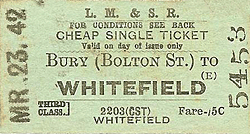 On 1st January 1948 Bury Bolton Street became part of the nationalised British Railways (London Midland Region). BR rebuilt the street level entrance as a single-storey brick structure with a flat roof, containing the booking office and staff accommodation, and it opened on 30th June 1952. Facing onto the street the centrally located main entrance doorways were flanked by space for two shops. A new footbridge was also installed. As with the 1880s structure a corridor, carried above the line, led to the covered footbridge which connected down to the platforms. A clock tower, again in brick, was erected at the west end of the building on the street. On 1st January 1948 Bury Bolton Street became part of the nationalised British Railways (London Midland Region). BR rebuilt the street level entrance as a single-storey brick structure with a flat roof, containing the booking office and staff accommodation, and it opened on 30th June 1952. Facing onto the street the centrally located main entrance doorways were flanked by space for two shops. A new footbridge was also installed. As with the 1880s structure a corridor, carried above the line, led to the covered footbridge which connected down to the platforms. A clock tower, again in brick, was erected at the west end of the building on the street.
In 1951, because the electrical equipment was life-expired and investment was not thought worthwhile, electric services on the Holcombe Brook line were replaced with steam Push Pull Trains. Passenger services on the Holcombe Brook branch were withdrawn soon after, on 5th May 1952.
In 1954 the lines to the north of Bury were considered busy enough to warrant the introduction of modern rolling stock, and it was reported in the local press that new diesel multiple units (DMUs) were to be introduced on Bacup line services; they entered service in February 1956. Thirty-five trains ran to Bacup and thirteen ran in each direction between Colne and Manchester Victoria. Along with the frequent electric service this was the most intensive service that the line would see
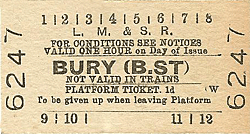 The purpose of The reshaping of British Railways (Beeching Report) of March 1963 was to create an economically viable network, involving the closure of many loss-making passenger lines and stations. The report’s proposals for Lancashire and north Manchester were astonishing. The entire route from Manchester via Bury Bolton Street to Bacup and Accrington was earmarked for closure, yet the nearby Manchester – Oldham – Rochdale and the Bolton – Bury Knowsley Street – Rochdale lines were not. Services to Colne were rationalised and cut back to Accrington. The absurdity of withdrawing passenger services on the heavily used, electrified service between Manchester and Bury was acknowledged when, on 8th February 1965, the Minister of Transport refused consent to closure. However on 14th September 1966 the Minister gave permission for the Rawtenstall to Bacup and Stubbins Junction to Accrington lines to close, which they did on 5th December 1966. Thereafter the only northbound trains from Bury were a shuttle service to Rawtenstall. The March 1967 timetable showed fifteen services between Bury and Rawtenstall at irregular intervals, and two extra workings on Saturdays, one in the early afternoon and another late at night. No trains ran on Sundays. The purpose of The reshaping of British Railways (Beeching Report) of March 1963 was to create an economically viable network, involving the closure of many loss-making passenger lines and stations. The report’s proposals for Lancashire and north Manchester were astonishing. The entire route from Manchester via Bury Bolton Street to Bacup and Accrington was earmarked for closure, yet the nearby Manchester – Oldham – Rochdale and the Bolton – Bury Knowsley Street – Rochdale lines were not. Services to Colne were rationalised and cut back to Accrington. The absurdity of withdrawing passenger services on the heavily used, electrified service between Manchester and Bury was acknowledged when, on 8th February 1965, the Minister of Transport refused consent to closure. However on 14th September 1966 the Minister gave permission for the Rawtenstall to Bacup and Stubbins Junction to Accrington lines to close, which they did on 5th December 1966. Thereafter the only northbound trains from Bury were a shuttle service to Rawtenstall. The March 1967 timetable showed fifteen services between Bury and Rawtenstall at irregular intervals, and two extra workings on Saturdays, one in the early afternoon and another late at night. No trains ran on Sundays.
With effect from 19th April 1970 the line to Rawtenstall became a single-track branch. In the final full year’s timetable from May 1971 weekday services had been reduced to twelve in each direction, with thirteen on Saturdays, the late night Saturday working having ceased by May 1970.
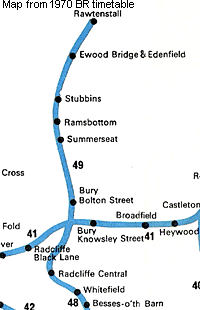 On 3rd June 1972 the last services to Rawtenstall operated. The 21:22 arrival at Bury from Rawtenstall marked the end of all passenger services to the north of Bury Bolton Street Station. The station became a terminus for the first time in its existence. Goods trains continued to run northwards to a coal concentration depot at Rawtenstall. The electric train service to Manchester remained popular and ran at a 30-minute frequency throughout most of the day, increasing to 20-minute intervals in May 1977. No Sunday services ran. On 3rd June 1972 the last services to Rawtenstall operated. The 21:22 arrival at Bury from Rawtenstall marked the end of all passenger services to the north of Bury Bolton Street Station. The station became a terminus for the first time in its existence. Goods trains continued to run northwards to a coal concentration depot at Rawtenstall. The electric train service to Manchester remained popular and ran at a 30-minute frequency throughout most of the day, increasing to 20-minute intervals in May 1977. No Sunday services ran.
In 1974 British Rail demolished the original ELR building of 1846. The area on which it formerly stood became a car park.
In the late 1970s the GMPTE decided to create a new bus and rail interchange at Bury, closer to the town centre. The new facility was opened on 17th March 1980, Bolton Street station closed on the same day. For a few months coal trains continued to pass through Bolton Street, but by December 1980 they had ceased. On14th February 1981 a railtour passed through Bury Bolton Street, having travelled to via Heywood and Bury Knowsley Street: this was the Rossendale Farewell marking the complete closure of the line. The train travelled to Rawtenstall and back, and after it had departed the line was closed completely.
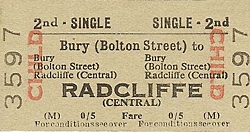 However a year later, on 28th March 1982, a railtour made three return trips from Bury Bolton Street to Rawtenstall. This was The Rossendale Phoenix, organised by a preservation group named the East Lancashire Railway (ELR) after the original company. They had entered into negotiations with British Rail with a view to reopening the line from Bury to Rawtenstall. Supported by the local authorities, the ‘new’ ELR reopened Bury Bolton Street to passenger services on 25thJuly 1987. Initially trains ran only to Ramsbottom. On 17th August 1991 the Bury Interchange to Manchester Victoria via Prestwich line closed pending its conversion into a tramway as part of the Manchester Metrolink system. This left Bury Bolton Street to Ramsbottom isolated from the national rail network for the first time since 1846. On 27th April 1991 the ELR extended their services to Rawtenstall. The line became a major tourist attraction. However a year later, on 28th March 1982, a railtour made three return trips from Bury Bolton Street to Rawtenstall. This was The Rossendale Phoenix, organised by a preservation group named the East Lancashire Railway (ELR) after the original company. They had entered into negotiations with British Rail with a view to reopening the line from Bury to Rawtenstall. Supported by the local authorities, the ‘new’ ELR reopened Bury Bolton Street to passenger services on 25thJuly 1987. Initially trains ran only to Ramsbottom. On 17th August 1991 the Bury Interchange to Manchester Victoria via Prestwich line closed pending its conversion into a tramway as part of the Manchester Metrolink system. This left Bury Bolton Street to Ramsbottom isolated from the national rail network for the first time since 1846. On 27th April 1991 the ELR extended their services to Rawtenstall. The line became a major tourist attraction.
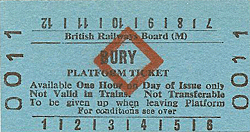 The ‘new’ ELR wanted to re-establish a connection with the national rail network. The only option available was the route via the ‘Bury East Fork’ and the line to Heywood. Unfortunately this route was severed by the line into Bury Interchange which had been converted into a tramway. A new bridge would have to be built on the site of Bury Knowsley Street station to carry the railway over the tramway. The new bridge opened in 1993, but it was not until 25th July 2003 that passenger services began running to Heywood. Through excursions from the national network also started to run after this date. The ‘new’ ELR wanted to re-establish a connection with the national rail network. The only option available was the route via the ‘Bury East Fork’ and the line to Heywood. Unfortunately this route was severed by the line into Bury Interchange which had been converted into a tramway. A new bridge would have to be built on the site of Bury Knowsley Street station to carry the railway over the tramway. The new bridge opened in 1993, but it was not until 25th July 2003 that passenger services began running to Heywood. Through excursions from the national network also started to run after this date.
By 2010 the ELR had become one of Britain’s premier preserved lines. At its hub is Bury Bolton Street station which has been fully restored to reflect the British Railways era of the 1950s and 60s.
Tickets from Michael Stewart , route map drawn by Alan Young, timetables from Chris Totty
Click here to see of film of a train journey between Bury and Bacup in 1966
See also the Ramsbottom Model Railway Club web site which features 106 old photographs of the East Lancashire Railway and photographs of the clubs excellent layout of Ramsbottom & Stubbins.
Sources:
To see other stations on the East Lancashire Railway Clifton Junction - Bacup line click on the station name on the station name:
Clifton Junction, Molyneux Brow, Ringley Road, Radcliffe Bridge, Withens Lane, Summerseat, Ramsbottom, Helmshore, Haslingden, Baxenden & Accrington
See also Stubbins Junction to Bacup: Stubbins, Irwell Vale (new station on the ELR), Ewood Bridge & Edenfield, Rawtenstall, Clough Fold,
Waterfoot for Newchurch, Stacksteads & Bacup |

bury_street_old2.jpg)

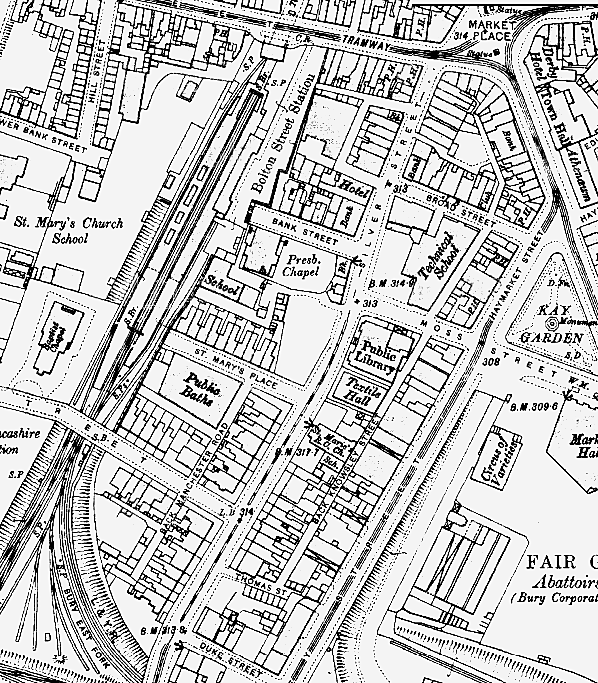
bury_street_old1.jpg)
bury_street_old13.jpg)
bury_street_old5.jpg)
bury_street_old10.jpg)
street_old1.jpg)
bury_street_old4.jpg)
 Bury Bolton Street, the principal station on the line, opened for public services on 28th September 1846. It was originally named Bury, and its main access was from Bolton Street, close to the centre of Bury. The station was not actually completed until 23rd August 1847. Located below street level in a stone wall-lined cutting, a sloping driveway led down to platform level, east of the line. At the Bolton Street end were wrought iron gates bearing the crest of the ELR, with ornamental pillars. There were three platform faces: two were on an island platform on the west side of the station. On the other (southbound) platform, on the east side, was a three-storey Italianate building with a 60-yard frontage and 6-yard depth that contained the usual station facilities but was also the head office of the ELR. It was brick-built with stone quoins and a hipped roof. As at its minor stations the ELR favoured round-headed window and door openings. On the ground floor, facing the platform, there were seventeen of them, with more windows of that style on the first floor, and segmental arches above the windows on the upper storey. An overall train shed, 91 yards in length, was provided, its roof attached to the main building and supported by pillars on the northbound platform.
Bury Bolton Street, the principal station on the line, opened for public services on 28th September 1846. It was originally named Bury, and its main access was from Bolton Street, close to the centre of Bury. The station was not actually completed until 23rd August 1847. Located below street level in a stone wall-lined cutting, a sloping driveway led down to platform level, east of the line. At the Bolton Street end were wrought iron gates bearing the crest of the ELR, with ornamental pillars. There were three platform faces: two were on an island platform on the west side of the station. On the other (southbound) platform, on the east side, was a three-storey Italianate building with a 60-yard frontage and 6-yard depth that contained the usual station facilities but was also the head office of the ELR. It was brick-built with stone quoins and a hipped roof. As at its minor stations the ELR favoured round-headed window and door openings. On the ground floor, facing the platform, there were seventeen of them, with more windows of that style on the first floor, and segmental arches above the windows on the upper storey. An overall train shed, 91 yards in length, was provided, its roof attached to the main building and supported by pillars on the northbound platform.
 On 1st May 1848 another line opened through Bury: built by the Lancashire & Yorkshire Railway (LYR) it ran from west to east through the town, passing beneath the ELR line immediately south of Bury station. The LYR opened their own station named Bury Market Place (later renamed Bury Knowsley Street) a short distance south-east of Bury station. On 20th November 1848 a connection - ‘Bury East Fork’ - from the south end of Bury station to the west end of Bury Knowsley Street station was built to link the lines, allowing through passenger and goods services between the two companies’ lines.
On 1st May 1848 another line opened through Bury: built by the Lancashire & Yorkshire Railway (LYR) it ran from west to east through the town, passing beneath the ELR line immediately south of Bury station. The LYR opened their own station named Bury Market Place (later renamed Bury Knowsley Street) a short distance south-east of Bury station. On 20th November 1848 a connection - ‘Bury East Fork’ - from the south end of Bury station to the west end of Bury Knowsley Street station was built to link the lines, allowing through passenger and goods services between the two companies’ lines.  On 13th May 1859 the LYR absorbed the ELR. They saw the route between Clifton Junction and Accrington as a useful alternative to their Manchester and Leeds line (which was by this date at capacity) for Trans-Pennine services. They ran numerous express passenger and goods services via Bury, including many of its excursions via the former ELR line.
On 13th May 1859 the LYR absorbed the ELR. They saw the route between Clifton Junction and Accrington as a useful alternative to their Manchester and Leeds line (which was by this date at capacity) for Trans-Pennine services. They ran numerous express passenger and goods services via Bury, including many of its excursions via the former ELR line.  In the early 1900s the LYR was facing increasing competition from new electric tramways, notably on its busy Prestwich line. The company considered electrification as a means of challenging tramway competition. The LYR were approached by the Dick Kerr & Co who were early pioneers of electric railways. They suggested to the LYR that they could electrify one of their lines to demonstrate the electrification technology to potential customers: Dick Kerr specifically had in mind a contract to electrify a line in Brazil. The Holcombe Brook branch was selected and electrified using 3500v dc overhead wires, and on 29th July 1913 electric services were introduced between Bury Bolton Street and Holcombe Brook.
In the early 1900s the LYR was facing increasing competition from new electric tramways, notably on its busy Prestwich line. The company considered electrification as a means of challenging tramway competition. The LYR were approached by the Dick Kerr & Co who were early pioneers of electric railways. They suggested to the LYR that they could electrify one of their lines to demonstrate the electrification technology to potential customers: Dick Kerr specifically had in mind a contract to electrify a line in Brazil. The Holcombe Brook branch was selected and electrified using 3500v dc overhead wires, and on 29th July 1913 electric services were introduced between Bury Bolton Street and Holcombe Brook.
 The trial was a success, and the LYR pressed ahead with electrification between Bury Bolton Street and Manchester Victoria, via Prestwich. Interestingly the LYR chose the side-contact live rail system at 1200v dc rather than overhead wires used on the Holcombe Brook line. A frequent service of electric trains began on the Prestwich Route on 17th April 1916. It proved very popular, passenger journeys increasing from 1,884,776 in 1907 to 2,518,638 by the end of 1916. Bacup line trains were diverted via Bury Knowsley Street and Heywood as soon as the electric services began. This added a considerable mileage to their route but it was assumed that most passengers from Bacup line stations to Manchester would change onto the electric services at Bury Bolton Street.
The trial was a success, and the LYR pressed ahead with electrification between Bury Bolton Street and Manchester Victoria, via Prestwich. Interestingly the LYR chose the side-contact live rail system at 1200v dc rather than overhead wires used on the Holcombe Brook line. A frequent service of electric trains began on the Prestwich Route on 17th April 1916. It proved very popular, passenger journeys increasing from 1,884,776 in 1907 to 2,518,638 by the end of 1916. Bacup line trains were diverted via Bury Knowsley Street and Heywood as soon as the electric services began. This added a considerable mileage to their route but it was assumed that most passengers from Bacup line stations to Manchester would change onto the electric services at Bury Bolton Street. 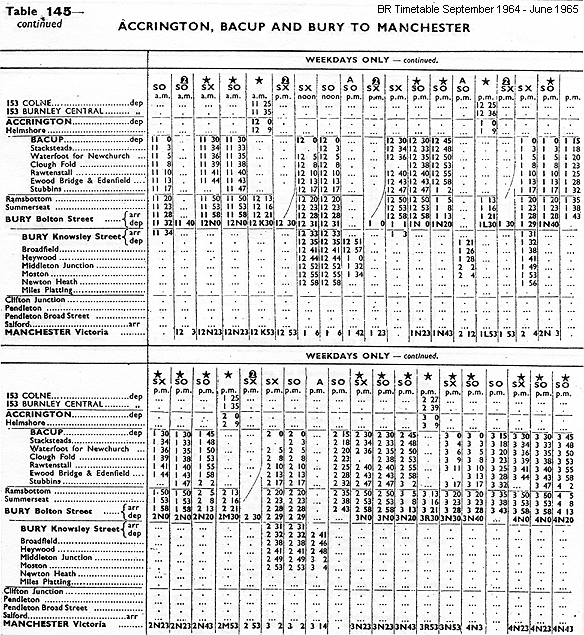
 By 1932 passengers using Bury Bolton Street station could travel to a wide variety of destinations, They had the choice of three separate routes to Manchester Victoria, services to Accrington, Bacup, Burnley, Colne and Holcombe Brook as well as shorter workings to Bury Knowsley Street and Ramsbottom. In all there were ninety-nine weekday southbound departures from Bolton Street. By far the majority were electrics on the Prestwich route. They ran at least every twenty minutes for most of the day. The first southbound train, an electric, left at 5:15 am for Manchester Victoria. The last southbound service departed at 11:10 pm for Manchester. Going northbound there were sixty eight trains. Twenty-nine of the sixty-eight departures were the electric service to Holcombe Brook. Of the remainder twenty one went to Bacup with the rest taking the Accrington route and most of them going to Colne. The first northbound train left for Stubbins at 5:30 am. The last was for Bacup and departed at 11.17 pm..
By 1932 passengers using Bury Bolton Street station could travel to a wide variety of destinations, They had the choice of three separate routes to Manchester Victoria, services to Accrington, Bacup, Burnley, Colne and Holcombe Brook as well as shorter workings to Bury Knowsley Street and Ramsbottom. In all there were ninety-nine weekday southbound departures from Bolton Street. By far the majority were electrics on the Prestwich route. They ran at least every twenty minutes for most of the day. The first southbound train, an electric, left at 5:15 am for Manchester Victoria. The last southbound service departed at 11:10 pm for Manchester. Going northbound there were sixty eight trains. Twenty-nine of the sixty-eight departures were the electric service to Holcombe Brook. Of the remainder twenty one went to Bacup with the rest taking the Accrington route and most of them going to Colne. The first northbound train left for Stubbins at 5:30 am. The last was for Bacup and departed at 11.17 pm..
 On 1st January 1948 Bury Bolton Street became part of the nationalised British Railways (London Midland Region). BR rebuilt the street level entrance as a single-storey brick structure with a flat roof, containing the booking office and staff accommodation, and it opened on 30th June 1952. Facing onto the street the centrally located main entrance doorways were flanked by space for two shops. A new footbridge was also installed. As with the 1880s structure a corridor, carried above the line, led to the covered footbridge which connected down to the platforms. A clock tower, again in brick, was erected at the west end of the building on the street.
On 1st January 1948 Bury Bolton Street became part of the nationalised British Railways (London Midland Region). BR rebuilt the street level entrance as a single-storey brick structure with a flat roof, containing the booking office and staff accommodation, and it opened on 30th June 1952. Facing onto the street the centrally located main entrance doorways were flanked by space for two shops. A new footbridge was also installed. As with the 1880s structure a corridor, carried above the line, led to the covered footbridge which connected down to the platforms. A clock tower, again in brick, was erected at the west end of the building on the street.
 The purpose of The
The purpose of The On 3rd June 1972 the last services to Rawtenstall operated. The 21:22 arrival at Bury from Rawtenstall marked the end of all passenger services to the north of Bury Bolton Street Station. The station became a terminus for the first time in its existence. Goods trains continued to run northwards to a coal concentration depot at Rawtenstall. The electric train service to Manchester remained popular and ran at a 30-minute frequency throughout most of the day, increasing to 20-minute intervals in May 1977. No Sunday services ran.
On 3rd June 1972 the last services to Rawtenstall operated. The 21:22 arrival at Bury from Rawtenstall marked the end of all passenger services to the north of Bury Bolton Street Station. The station became a terminus for the first time in its existence. Goods trains continued to run northwards to a coal concentration depot at Rawtenstall. The electric train service to Manchester remained popular and ran at a 30-minute frequency throughout most of the day, increasing to 20-minute intervals in May 1977. No Sunday services ran. However a year later, on 28th March 1982, a railtour made three return trips from Bury Bolton Street to Rawtenstall. This was The Rossendale Phoenix, organised by a preservation group named the East Lancashire Railway (ELR) after the original company. They had entered into negotiations with British Rail with a view to reopening the line from Bury to Rawtenstall. Supported by the local authorities, the ‘new’ ELR reopened Bury Bolton Street to passenger services on 25thJuly 1987. Initially trains ran only to Ramsbottom. On 17th August 1991 the Bury Interchange to Manchester Victoria via Prestwich line closed pending its conversion into a tramway as part of the Manchester Metrolink system. This left Bury Bolton Street to Ramsbottom isolated from the national rail network for the first time since 1846. On 27th April 1991 the ELR extended their services to Rawtenstall. The line became a major tourist attraction.
However a year later, on 28th March 1982, a railtour made three return trips from Bury Bolton Street to Rawtenstall. This was The Rossendale Phoenix, organised by a preservation group named the East Lancashire Railway (ELR) after the original company. They had entered into negotiations with British Rail with a view to reopening the line from Bury to Rawtenstall. Supported by the local authorities, the ‘new’ ELR reopened Bury Bolton Street to passenger services on 25thJuly 1987. Initially trains ran only to Ramsbottom. On 17th August 1991 the Bury Interchange to Manchester Victoria via Prestwich line closed pending its conversion into a tramway as part of the Manchester Metrolink system. This left Bury Bolton Street to Ramsbottom isolated from the national rail network for the first time since 1846. On 27th April 1991 the ELR extended their services to Rawtenstall. The line became a major tourist attraction. 
 The ‘new’ ELR wanted to re-establish a connection with the national rail network. The only option available was the route via the ‘Bury East Fork’ and the line to Heywood. Unfortunately this route was severed by the line into Bury Interchange which had been converted into a tramway. A new bridge would have to be built on the site of Bury Knowsley Street station to carry the railway over the tramway. The new bridge opened in 1993, but it was not until 25th July 2003 that passenger services began running to Heywood. Through excursions from the national network also started to run after this date.
The ‘new’ ELR wanted to re-establish a connection with the national rail network. The only option available was the route via the ‘Bury East Fork’ and the line to Heywood. Unfortunately this route was severed by the line into Bury Interchange which had been converted into a tramway. A new bridge would have to be built on the site of Bury Knowsley Street station to carry the railway over the tramway. The new bridge opened in 1993, but it was not until 25th July 2003 that passenger services began running to Heywood. Through excursions from the national network also started to run after this date.

 Home Page
Home Page